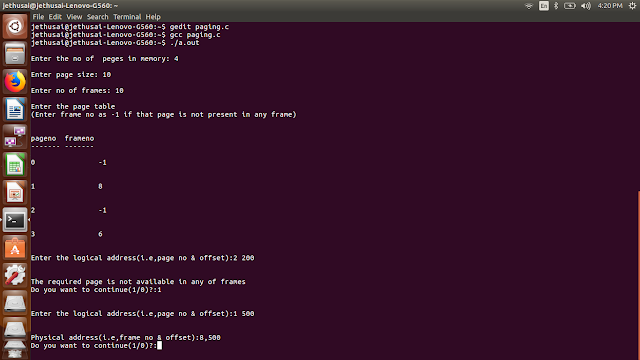Write C programs to simulate the Paging techniques of memory management
#include<stdio.h>
#define MAX 50
int main()
{
int page[MAX],i,n,f,ps,off,pno;
int choice=0;
printf("\nEnter the no of peges in memory: ");
scanf("%d",&n);
printf("\nEnter page size: ");
scanf("%d",&ps);
printf("\nEnter no of frames: ");
scanf("%d",&f);
for(i=0;i<n;i++)
page[i]=-1;
printf("\nEnter the page table\n");
printf("(Enter frame no as -1 if that page is not present in any frame)\n\n");
printf("\npageno\tframeno\n-------\t-------");
for(i=0;i<n;i++)
{
printf("\n\n%d\t\t",i);
scanf("%d",&page[i]);
}
do
{
printf("\n\nEnter the logical address(i.e,page no & offset):");
scanf("%d%d",&pno,&off);
if(page[pno]==-1)
printf("\n\nThe required page is not available in any of frames");
else
printf("\n\nPhysical address(i.e,frame no & offset):%d,%d",page[pno],off);
printf("\nDo you want to continue(1/0)?:");
scanf("%d",&choice);
}while(choice==1);
return 1;
}
Output:
#define MAX 50
int main()
{
int page[MAX],i,n,f,ps,off,pno;
int choice=0;
printf("\nEnter the no of peges in memory: ");
scanf("%d",&n);
printf("\nEnter page size: ");
scanf("%d",&ps);
printf("\nEnter no of frames: ");
scanf("%d",&f);
for(i=0;i<n;i++)
page[i]=-1;
printf("\nEnter the page table\n");
printf("(Enter frame no as -1 if that page is not present in any frame)\n\n");
printf("\npageno\tframeno\n-------\t-------");
for(i=0;i<n;i++)
{
printf("\n\n%d\t\t",i);
scanf("%d",&page[i]);
}
do
{
printf("\n\nEnter the logical address(i.e,page no & offset):");
scanf("%d%d",&pno,&off);
if(page[pno]==-1)
printf("\n\nThe required page is not available in any of frames");
else
printf("\n\nPhysical address(i.e,frame no & offset):%d,%d",page[pno],off);
printf("\nDo you want to continue(1/0)?:");
scanf("%d",&choice);
}while(choice==1);
return 1;
}
Output:

Good overview of memory allocation strategies. I’ve seen how dynamic loading and proper memory tracking can really help reduce system overhead—especially on machines with limited RAM. Tools that let you monitor and manually clear inactive memory can make a noticeable difference in everyday performance. ( https://memoryreduct.com/mem-reduct-download/)
ReplyDelete